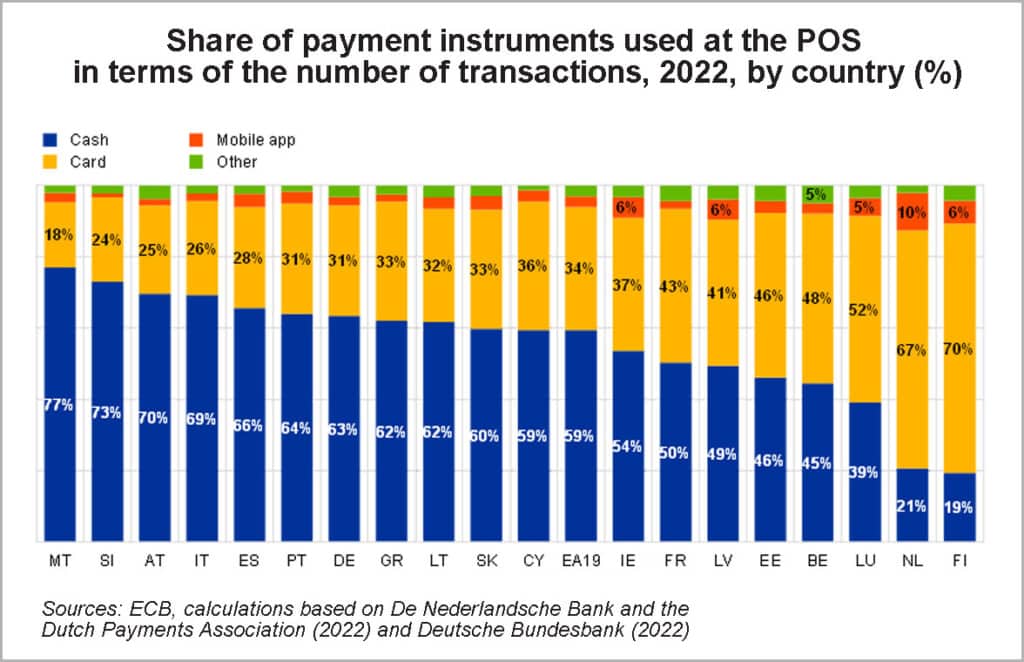
More than six in ten card payments made at the point of sale (POS) across European countries within the eurozone are now contactless (62%) compared with just over four in ten in 2019 (41%), a European Central Bank (ECB) survey reveals.
The survey of consumer payment habits also shows that contactless card payments now account for 50% of all in-store card transaction values across the eurozone, up from 27% in 2019, with that proportion rising to 74% in Slovenia, 75% in Slovakia and 81% in Cyprus.
Overall, cash remains the most frequently used means of payment at the point of sale, but its usage has declined since 2019 and for the first time cards now account for a higher share of POS transactions than cash in terms of value.
According to the survey, the proportion of cash POS transactions in the eurozone has fallen to 59% by volume and 42% by value compared with 72% by volume and 47% by value in 2019, while card POS transactions have risen to 34% from 25% by volume and to 46% from 43% by value over the same period.
The proportion of POS transactions made using a mobile app has also risen from less than 1% to 3% by volume and from 1% to 4% by value since 2019.
The ECB’s Study on the Payment Attitudes in Consumers in the Euro Area 2022 (SPACE) also shows that while 60% of consumers in the eurozone think it important to have cash as a payment option, 55% say they prefer making card or other cashless payments in stores, 22% say they prefer cash and 23% have no preference.
Regional variation
“There are large cross-country differences in the payment habits of consumers when purchasing goods or services at the POS. In several countries, a clear majority of POS payments in 2022 were made in cash,” the researchers say.
“The highest shares in terms of number of payments were observed in Malta (77%), Slovenia (73%), Austria (70%) and Italy (69%), and in terms of value of payments in Malta (65%), Lithuania (61%) and Slovenia (59%).
“Card payments were the most frequently used method at the POS in 2022 in four euro area countries: Finland (70%), the Netherlands (67%), Luxembourg (52%) and Belgium (48%). In Estonia, the share of card payments was almost identical to the share of cash payments (both 46%).
“Although payments with mobile apps have increased in recent years, their share in POS payments was still relatively low. The share of mobile payments (by number of transactions) was highest in the Netherlands (10%), and exceeded 5% in Finland, Ireland, Latvia and Luxembourg.”
Use cases
In addition, the survey shows that older age groups tend to use cash “relatively more often” than younger generations and that cash is most frequently used for payments at vending machines (74%), in restaurants and hotels (65%), and in supermarkets and other shops selling day-to-day goods (61%), but that the share of cash transactions has “declined by more than 10 percentage points” across a range of payment locations including venues for culture and sport, public offices, supermarkets, restaurants and hotels.
When asked about the advantages of card payments, 62% of respondents say the key benefit was not having to carry a lot of cash, 40% say they think card payments are faster, 37% say they think they are easier and 26% say they think they are safer.
“The ECB is committed to ensuring that consumers remain free to choose how to pay, both now and in the future,” ECB executive board member Fabio Panetta says.
“We are seeing confirmation of strong demand for both cash and digital payments. Our commitment to cash and our ongoing work on a digital euro aims to ensure that paying with public money is always an option.”
The survey was conducted with more than 40,000 consumers in 19 eurozone countries in late 2021 and early 2022.
Next: Visit the NFCW Expo to find new suppliers and solutions